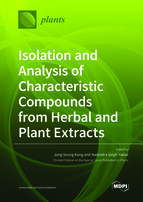Isolation and Analysis of Characteristic Compounds from Herbal and Plant Extracts
A special issue of Plants (ISSN 2223-7747). This special issue belongs to the section "Phytochemistry".
Deadline for manuscript submissions: closed (31 July 2021) | Viewed by 55689
Special Issue Editors
Interests: standardization of natural products; fingerprint analysis of herbal drugs; metabolic fate of herbal compounds
Interests: plant stress biology; genetic and epigenetic regulation of abiotic stress response; transposable elements regulation; transgenerational stress memory; multi-generational stress effects; extremophytes; Salicornia; Arabidopsis; novel stress-responsive genes
Special Issues, Collections and Topics in MDPI journals
Special Issue Information
Dear Colleagues,
Herbal and plant extracts show diverse activities and have been used for centuries as natural medicines for many health problems and diseases. Through the isolation and analysis of the compounds in the extracts, it is possible to understand why the extracts exhibit those activities, as well as the chemical metabolism of compounds that occur in plants and herbs. Recently, there have been increasing attempts to develop herbal and plant extracts into functional foods and drugs, but the legal requirements are becoming stricter. We need sophisticatedly defined extracts through the isolation and analysis of compounds comprising them in order to meet the legal requirements and to pursue quality control strategies in the production of functional foods and drugs.
This Special Issue of Plants will highlight the isolation, profiling, and analysis of compounds in herbal and plant extracts, as well as quality control and standardized processing strategies for extracts with characteristic compounds.
Prof. Dr. Jong Seong Kang
Dr. Narendra Singh Yadav
Guest Editors
Manuscript Submission Information
Manuscripts should be submitted online at www.mdpi.com by registering and logging in to this website. Once you are registered, click here to go to the submission form. Manuscripts can be submitted until the deadline. All submissions that pass pre-check are peer-reviewed. Accepted papers will be published continuously in the journal (as soon as accepted) and will be listed together on the special issue website. Research articles, review articles as well as short communications are invited. For planned papers, a title and short abstract (about 100 words) can be sent to the Editorial Office for announcement on this website.
Submitted manuscripts should not have been published previously, nor be under consideration for publication elsewhere (except conference proceedings papers). All manuscripts are thoroughly refereed through a single-blind peer-review process. A guide for authors and other relevant information for submission of manuscripts is available on the Instructions for Authors page. Plants is an international peer-reviewed open access semimonthly journal published by MDPI.
Please visit the Instructions for Authors page before submitting a manuscript. The Article Processing Charge (APC) for publication in this open access journal is 2700 CHF (Swiss Francs). Submitted papers should be well formatted and use good English. Authors may use MDPI's English editing service prior to publication or during author revisions.
Keywords
- isolation and analysis of compounds
- herbal and plant extracts
- quality control
- functional foods
- herbal drugs
- profiling
- standardized processing
- characteristic compounds








